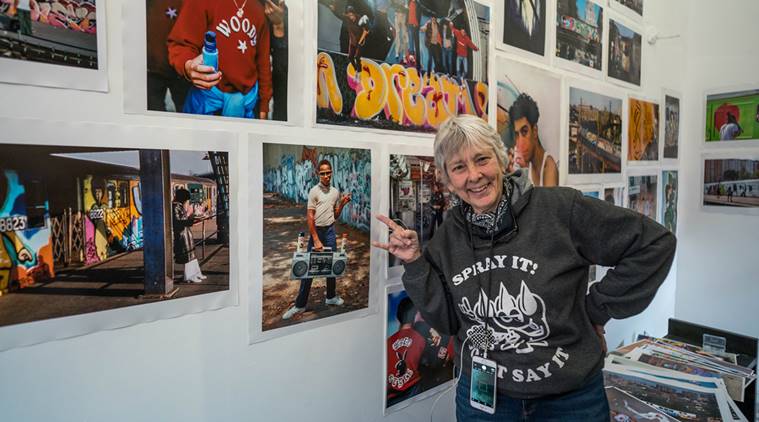Written by Surbhi Gupta |New Delhi |Updated: March 10, 2019 6:00:34 am
Photographer Martha Cooper on documenting the early years of graffiti and the slow, but steady, mainstream recognition of the art form
To Whom the Streets Belong: The New York-based photographer, 76, who is in the capital for the ongoing street art festival by St+Art Foundation, is known for capturing street art across the world.

American street photographer Martha Cooper has been documenting the murals in Delhi’s Lodhi Colony. We meet her between Blocks 5 and 8 where some children are playing, and the mural with the phrase “We Love Delhi” makes the backdrop. “Capturing street art with people in the frame makes it come alive,” she says. The New York-based photographer, 76, who is in the capital for the ongoing street art festival by St+Art Foundation, is known for capturing street art across the world. She rose to fame for documenting the New York City graffiti scene of the 1970s and 1980s in Subway Art (1984), a book which she created with fellow photographer Henry Chalfant. It later came to be known as the graffiti bible and had sold half a million copies by 2009.
Maryland-born Cooper was initiated into photography at the age of three. “My dad owned a camera store and he handed me one. I went about clicking anything that I found interesting, but I wasn’t really imagining it would be a career till I got older,” she says. Cooper graduated in art from Grinnell College, Iowa, and became the first female photojournalist to be employed by the New York Post. Her introduction to the world of graffiti came through a feature story about children playing on the streets without their parents. “One of the boys showed me a notebook in which he had made sketches, as practice before making them on a wall. The idea that these kids had their own art world drew me to the world of street art and graffiti,” she says. The boy introduced her to graffiti “king” Dondi (born Donald Joseph White), who allowed her to accompany him on his graffiti-making expeditions. Soon, she started following various graffiti artists in and around the Bronx, in New York City.
Last week, The New York Times wrote an obituary for Dondi as part of the ongoing series Overlooked, featuring tributes to those who were previously overlooked by the obituary section owing to their race or gender. “The Times has always been anti-graffiti so for them to celebrate a graffiti artist is a positive change,” says Cooper. They used Cooper’s photo of the artist straddling two subway cars in a Brooklyn train yard. People in the city hated graffiti, and thought of it as pure vandalism, she says. “They didn’t understand what the kids were writing and felt they were being attacked by the graffiti. But as soon as one started recognising what was written, then it became fun and more like a puzzle,” she says. Things have turned around in New York City since then: now, when street artists gentrify an area with their art, real estate prices shoot up, making housing unaffordable even for long-time residents.
The stigma around street art extended to books about it as well. “When Henry and I wanted to get a book published, it was hard to find a publisher, everyone kept rejecting us, until we found Thames & Hudson in England,” she says. But Subway Art took its time to make an impact. “It was a little disappointing at first because I thought it will give an immediate boost to my career as a photographer,” she says. The book slowly gained iconic status, though, and was instrumental in introducing graffiti and hip hop around the world. Featuring popular graffiti artists such as Zephyr, Seen, Kase2, Dondi Poem One and Lady Pink, it is known to be one of the most stolen books in the UK. “I didn’t expect it to be this popular. I thought I was photographing something very specific to New York. Frequently, after a photographer dies, the work generates interest. So it’s nice that in my lifetime people are enjoying the pictures that I took,” she says.






















No hay comentarios:
Publicar un comentario